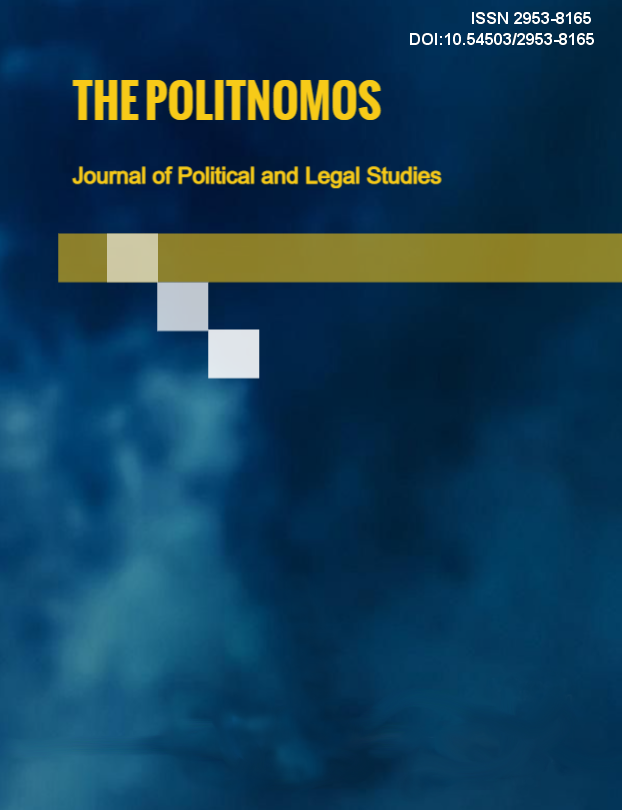Journal info

ABOUT THE JOURNAL
eISSN 3045-3046
DOI:10.54503/2953-8165
The POLITNOMOS is a multi-disciplinary scholarly peer reviewed and international fully open access journal that covers all areas of political science, law, political and legal philosophy. It aims to serve as a scholarly platform for research papers’ findings, discussions, and debates and introduce promising researchers and studies to the political and legal scientific communities.
The POLITNOMOS welcomes manuscripts that utilize political and legal research as well as philosophical methodology and concepts or that bridge overlapping fields of works relevant to Political Science and Law.
The POLITNOMOS emphasizes an impartial assessment of submitted papers, ensuring that methodology and findings are correct and accurate.
The journal invites authors – outstanding experts, beginning researchers, students, post-graduates, and lecturers interested in political processes and institutions, regional issues, political discourse and political culture, political theory and history, international relations, theory and history of law, constitutional and international law, political and legal philosophy, comparative law, etc.
Abstracting & Indexing


The main sections of the journal POLITNOMOS are:
POLITICAL PROCESS & INSTITUTIONS
REGIONAL POLITICS
POLITICAL SCIENCE THEORY
POLITICAL SCIENCE METHODOLOGY
POLITICAL PHILOSOPHY
DEMOCRATIZATION ISSUES
GENDER POLITICS
POST-SOVIET STUDIES
CONFLICTS
THEORY OF LAW
METHODOLOGY OF LAW
PHILOSOPHY OF LAW
CONSTITUTIONAL AND PUBLIC LAW
INTERNATIONAL LAW
For Authors
The POLITNOMOS welcomes the submission of original and significant contributions concerning political and legal sciences.
The authors have to send their manuscripts to the following email address: politnomos@gmail.com
Editor-in-Chief
Emil ORDUKHANYAN – PhD in Political Science, Associate Professor. Institute of Philosophy, Sociology and Law, National Academy of Sciences, Armenia
Phone: +37411530571
Email: ipsl@sci.am, emil.ordukhanyan@gmail.com
Editorial Board
Advisory editors
Levon SHIRINYAN – Doctor of Political Science, Professor. Institute of Philosophy, Sociology and Law, National Academy of Sciences, Armenia
Hayk SUKIASYAN – PhD in Political Science, Associate Professor. Institute of Philosophy, Sociology and Law, National Academy of Sciences, Armenia
Emil ORDUKHANYAN – PhD in Political Science, Associate Professor. Institute of Philosophy, Sociology and Law, National Academy of Sciences, Armenia
Nerses KOPALYAN – Doctor of Political Science, Assistant Professor, University of Nevada, Las Vegas, USA
Josiah MARINEAU – Doctor of Political Science, Associate Professor, University of North Carolina at Pembroke, USA
Otto LUCHTERHANDT – Doctor of Law, Professor. University of Hamburg, Germany
Tigran QOCHARYAN – Doctor of Political Science, Professor. National Defense Research University, MOD, Armenia
Hovhannes STEPANYAN – Doctor in Law, Professor. Institute of Philosophy, Sociology and Law, National Academy of Sciences, Armenia
Gor HOVHANNISYAN – Doctor of Law, Associate Professor. University of Hagen, Germany
Davit HAKOBYAN – PhD in Law, Institute of Philosophy, Sociology and Law, National Academy of Sciences, Armenia
Hayk KUPELYANTS — Doctor of Law, King’s College London, UK
Khachik HOVHANNISYAN — Doctor of Philosophy (Theology). Catholic University of Leuven, Belgium
Lilit SARVAZYAN – PhD in Philosophy, Associate Professor. Institute of Philosophy, Sociology and Law, National Academy of Sciences, Armenia
NOTES TO CONTRIBUTORS
MANUSCRIPT must:
- correspond to the topics of the journal,
- not include information about the author(s),
- be submitted in English, in Microsoft Office Word,
- not exceed 8000 words,
- page size – A5, margins – 2 cm from each side,
- font face – Times New Roman,
- font size for the text of the article – 12, for the footnotes – 10,
- line spacing for the text of the article – 1, first line – 0.5 cm (first line of the first paragraph after subtitles – none),
- line spacing for the footnotes – 1, hanging – 0.3 cm,
TITLE PAGE:
- should include the paper title, author name(s), author affiliation(s), running head, and page number.
Title
- should outline the general scope of the article,
- 3-4 lines down from the top,
- centered bold capitalized major words for the title,
- font size – 12.
Running head:
- in the page header of all pages,
- capital letters,
- aligned from left,
- font size – 12.
Subtitles:
- bold sentence case,
- font size – 12,
- first-line – none.
Authors’ data:
- one double-spaced line down the title, centered, italic,
- full name and email address of each author’s workplace, organization,
- position, rank, academic degree,
- ORCID iD (if available), email,
- the surnames and the first letter in names of authors should be full,
- when different authors have different affiliations, superscript numerals after author names should be used to connect the names to the appropriate affiliation(s).
ABSTRACT:
- should not exceed 250 words,
- should be informative and not contain general words and phrases,
- should describe the research, methodology and the results,
- should reflect the main content of the article taking into consideration the following viewpoints: subject, purpose, research results and conclusions,
- information contained in the title should not be duplicated in the abstract,
- should provide a good perspective on the final message of the article.
KEYWORDS:
- between 5 to 10,
- should be separated by a comma and end by a full stop.
TABLE/ FIGURE HEADING
- align left, table/figure and number (e.g., Table 1, Figure 1),
- table/figure title appears double-spaced line below the table/figure number capitalized in italic title case,
- figures/charts and tables created in MS Word should be included in the main text rather than at the end of the document. Figures and other files created outside Word (i.e., Excel, PowerPoint, JPG, TIFF, and EPS) should be submitted separately. Please add a placeholder note in the running text,
- if an embedded table or figure appears on the same page as the text, place it at either the top or the bottom of the page, and insert a blank double-spaced line to separate the table or figure from the adjacent text.
INTRODUCTION:
- should reflect the article’s contribution to the scope of political science, law, political, legal philosophy and related fields of research.
- should reflect the current concerns in the area,
- should specify the research objectives.
MAIN TEXT
- should reflect the main arguments and evidence,
- may contain sections with the appropriate headings.
CONCLUSION:
- should be clearly formulated and presented.
TYPES OF MANUSCRIPT
- scholarly articles and unpublished research papers,
- essays of symposiums and scientific events,
- article reviews, book reviews,
- scientific reports.
REFERENCES & IN-TEXT CITATIONS
APA citation format must be used for the in-text citations and references.
IN-TEXT CITATIONS
When the author is mentioned in the running text, place the publication date in parentheses (narrative citation).
For example, Huntington (1993)
When the author is not mentioned in the running text, include the author’s last name and the year of publication in parentheses. Separate author and year by a comma (parenthetical citation).
For example, (Huntington, 1993)
Two authors
(Lintz & Stepan, 1996),
Lintz & Stepan (1966)
Three and more authors
(Smith et al., 1998), Smith et al. (1998)
Two or more works with different authors
(Torbakov, 2019; Mankoff, 2022)
Two or more works with the same author
(Huntington, 1993, 1996)
Citations with the same author(s) and with the same publication year
Identify citations with the same author(s) and with the same publication year by the suffixes a, b, c, and so forth. Assign the suffixes alphabetically by title (consistent with the order in the reference list).
(Kissinger, 1979a, 1979b).
Authors with the same surname
If a reference list contains works by two leading authors with the same surname, provide the initials of both authors in all text citations.
R. Smith (2011) and S. S. Smith (2014).
Works with an unknown publication year
When the publication year of a work is unknown, use the abbreviation ‘n.d.’ (no date).
(Carter, n.d.).
When the author’s name is unknown, use the source title.
(Source Title, 2020).
When the page number is missing either use an alternative locator or omit the page number.
(James, 2020, Chapter 3) or (James, 2020).
Direct quotations
In a direct quote include the page number or specific parts of a source.
(Brzezinski, 2000, p. 175)
Brzezinski (2000) … (p. 175)
(Atkinson, 2007, Chapter 8)
(Huntington, 1996, Table 2.1, p. 55)
Secondary sources
(Brzezinski, as cited in Kakachia, 2011)
REFERENCES
References must be arranged in alphabetical order by the last name of the (first) author, followed by the initials. (Hanging – 1.5).
The Latin transliteration of all non-Latin references should be included together with the English translation. There is no need to transliterate the author(s) surname(s).
Вебер, М. (1990). Наука как призвание. Москва: Прогресс.
Weber, M. (1990). Nauka kak prizvaniye (Science as a Vocation). Moscow: Progress.
Works by the same author (or by the same two or more authors in the same order) with the same publication date are arranged alphabetically by title. Add lowercase letters – a, b, c, etc. – immediately after the year.
Fukuyama, F. (2018a). Against Identity Politics: The New Tribalism and the Crisis of Democracy. Foreign Affairs, 97(5), 90-114.
Fukuyama, F. (2018b). Why National Identity Matters? Journal of Democracy, 29(4) 5-15. doi:10.1353/jod.2018.0058.
Print book or its digital version
Waltz, K., (1979). Theory of International Relations. Reading, MA: Addison-Wesley.
Smith, G., Law, V., Wilson, A., Bohr, A., & Allworth E. (1998). Nation-Building in the Post-Soviet Borderlands: The Politics of National Identities. Cambridge and New York: Cambridge University Press.
Brzezinski, Z. (1997). The grand chessboard: American primacy and its geostrategic imperatives. Retrieved June 15, 2023 from: http://armpolsci.com/books/.
Chapter in an edited book
Norris, P. & Inglehart R. (2016). Muslim Integration into Western Cultures: Between Origins and Destinations. In T. Abbas (Ed.), Muslim Diasporas in the West: Critical Readings in Sociology (228-251). London, England: Routledge.
Articles
Phillips, N. (2017). Power and inequality in the global political economy. International Affairs, 93(2), 429–444. DOI: 10.1093/ia/iix019
Newspaper article
Miliband, E. (2011, December 1). British Politics is “Far Too Macho”. The Telegraph. Retrieved June 15, 2023 from:https://www.telegraph.co.uk/
Electronic sources
Encyclopedia
Graham, G. (2005). Behaviorism. In E. N. Zalta (Ed.), The Stanford encyclopedia of philosophy (Fall 2007 ed.). Retrieved June 15, 2023 from: http://plato.stanford.edu/entries /behaviorism/
Dictionary
Consensus. (n.d.). In Merriam-Webster’s online dictionary (11th ed.). Retrieved June 15, 2023 from: https://www.merriam-webster.com/dictionary/consensus
Websites
Bercow, J. (2010, July 6). Speech to the Centre for Parliamentary Studies. Retrieved June 15, 2023 from: www.johnbercow.co.uk.
Video clip
University of California, Berkeley. (2008). Political Science 179: Election 2008, lecture 1 [Video] YouTube. http:// www.youtube.com/watch?v=3D9Dq8VsxnM
Legal Cases
Thorne v. Deas, 4 Johns. 84 (N.Y. Sup. Ct. Feb. 1, 1809) https://www.casebriefs.com/blog/law/torts/torts-keyed-to-dobbs/contract-and-duty/thorne-v-deas/
Treaties, agreements, declarations, international conventions
Declaration on Principles of International Law concerning Friendly Relations and Cooperation among States in accordance with the Charter of the United Nations, 24 October 1970. Retriefed June 15, 2023 from: https://www.refworld.org/docid/3dda1f104.html
Proceedings, published in book form
To cite published proceedings from a book, use the same format as for a book or book chapter.
Palkovska, I. F. (2018). Characteristics of Judgments of the EU Court of Justice. In K. Cermakova & J. Rotschedl (Eds.), 3rd Law & Political Science Conference, Lisbon, (pp. 30-52), International Institute of Social and Economic Sciences. DOI: 10.20472/LPC.2018.003.002
Proceedings, published regularly online
To cite proceedings that are published regularly, use the same format as for a journal article.
Szabo, S. F. (1991). The New Europeans: Beyond the Balance of Power. Proceedings of the Academy of Political Science, 38(1),26–34. https://doi.org/10.2307/1173810
Conference paper, from the web
Wentworth, D. (2012, November). E-learning at a glance. Paper presented at the Distance Education Conference. Retrieved June 15, 2023 from: http://www.umuc.au/conference/distance_education.html
Doctoral dissertation / Master’s thesis
Christiansen, W. T. (2020). International Conflict, Political Leaders, and Accountability. (Doctoral dissertation). Retrieved June 15, 2023 from: https://scholarcommons.sc.edu/etd/5794
Bang-Jensen, B. (2022). Principled and Pragmatic Exit: Understanding Treaty Withdrawal. (Doctoral dissertation, University of Washington). Retrieved June 15, 2023 from: https://www.polisci.washington.edu/research/dissertations
GRAPHS AND DIAGRAMS
If the manuscript contains non-alphabetic characters (e.g. logical formulae, diagrams) then:
- the PDF version of the text should be attached for the demanded verification,
- photo images should be of high quality.













